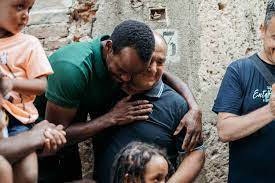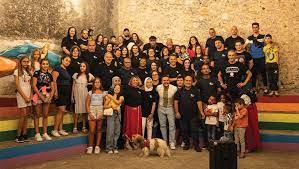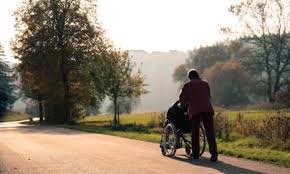Italy: Southern small-town revival fuelled by migration

Rome: “In Camini, I live in a culturally rich and respectful community, where we treat each other like family,” says Zakaria Jlousi, a 26-year-old Syrian who has been calling the small hilltop town in Calabria home for the past two years. As a multicultural mediator, he helps migrants, asylum seekers and refugees understand and navigate diverse cultural landscapes.
Situated on southern Italy’s Ionian coast, Camini had been plagued by depopulation as many residents left for better opportunities in northern Italy or abroad over the past decades.
Between 1991 and 2011, Camini’s population dropped by 27 per cent, from 630 to 458. The town had reached a dire state, lacking even a single open restaurant or post office, while its school was on the brink of closure. However, over the past 10 years, Camini has undergone a remarkable revival by welcoming and integrating a diverse range of cross-border migrants into its daily life, such as Jlousi.
The newcomers revived the social fabric of the community by introducing new cultures and ideas

It is now home to 118 people from various parts of the world, including Syria, Bangladesh and Turkey. They live alongside the 730 or so local residents and actively participate in a two-year integration programme, financially supported by the government with contributions from the European Union.
Started in 2001, the programme relies on the voluntary participation of local institutions in reception and integration projects, and is taking place throughout Italy. Migrants can enhance their skills, learn Italian and integrate into both the local community and broader Italian society.
According to a 2016 environmental association report, close to 2,500 small towns and villages are perilously depopulated. Many of these struggling towns are concentrated in Calabria and Sicily. Notably, these two regions have borne the brunt of the migrant influx, witnessing tens of thousands of arrivals in 2022 alone.
As of 2023, Camini is one of 108 local authorities in Calabria implementing migrant, asylum seeker and refugee integration projects as part of the governmental initiative. For Camini, this is a way to combat depopulation and boost job opportunities. Neighbouring places such as Riace, just 3km away, and Naro in Sicily, have also experienced economic and social rejuvenation through their inclusive and sustainable approach to integration.
For Camini, the integration project has put the town back on the map. According to Serena Franco, an Italian teacher working at Jungi Mundu, the social co-operative managing the local reception centre: “Camini is a place where people arrive now.”
To house the newcomers, 40 previously run-down properties have been renovated and serve as mixed-use accommodation. “Some rooms house migrants, and others are destined for tourists,” Franco explains.
On arrival, many of the migrants, refugees and asylum seekers need substantial support – from psychological and medical care to vocational assistance. This has generated new job opportunities not only for locals but also for people from nearby towns and villages who commute daily to work in Camini, such as Franco herself.
‘‘They attend workshops which prepare them for tailoring, craftsmanship and artisanal production,” Franco explains. “They learn how to do something and can use this knowledge in other environments beyond Camini. They also go to school for four hours a day to learn Italian,’’ she says.
Franco points out that when they first arrive, many newcomers are wary because Camini is such a small place. However, once they realise the community is welcoming and prepared to accommodate them, their perspective changes.
“They live together with the locals in a small place, and they share the space and different points of views, cultures and foods,” Franco says. “The kids’ interactions are also very important. They go to school together and then they go to each other’s houses to hang out. It’s a normal environment,’’ she adds.
While many leave Camini at the end of the two-year Jungi Mundu programme due to limited job opportunities, some, such as Jlousi and Filmon Tesfalem from Eritrea, choose to make it their permanent home. Tesfalem, who survived a perilous sea voyage, now co-ordinates the work of Camini’s newest residents on a local farm and, with Jungi Mundu’s help, has even purchased a house.
Further south, in Sicily, the medieval town of Naro, which has a population of around 7,500 residents, has developed a very specific role in migrant reception by becoming a hub for unaccompanied migrant children. Two dedicated reception centres – one for boys, one for girls – each accommodating around 20, serve as sanctuaries for the youngsters.
In 2018, Sicily was home to a significant portion of Italy’s 8,900 unaccompanied migrant children, with one-third of them residing in reception centres. Most of the youths were aged 16 to 17.
To support their integration, Unicef partnered with JA Italy, a non-profit organisation specialising in youth economic and entrepreneurial education, to launch Upshift. The programme encourages the young unaccompanied migrants and their Italian peers to discuss ideas that they can then turn into projects with social impact. Some of Naro’s businesses, including a Sicilian-Senegalese fusion restaurant, embraced this initiative, providing employment to many young migrants.
Some of the unaccompanied boys in Naro told Unicef that, while Naro may not be a bustling hub of activity, they could envision themselves as valuable contributors to the town’s development, forging a sense of ownership and purpose within their newfound community. Apart from the Upshift funding, Naro has also benefitted from the Italian government’s support for other integration projects.
The transformative impact of integration extends beyond Camini and Naro, reaching yet another hilltop town on the Ionian Sea – Riace.
Resident Ada Alvaro, a recent history graduate awaiting an assignment to teach Italian language and literature in the Piemonte region, finds that the primary impact of migrant, asylum seeker and refugee reception in Riace has been social rather than economic: “The newcomers revived the social fabric of the community by introducing new cultures and ideas, fostering open-mindedness among the residents,” she says.
Alvaro also acknowledges that their presence invigorated certain employment areas in Riace, especially in blue-collar jobs such as carpentry and farmwork in local fruit and vegetable fields.
According to Alvaro, Riace’s population had mixed feelings about the integration initially: “One part of the community was very welcoming, the other part was sceptical,” she says.
Alvaro says most of the sceptics gradually changed their stance as they witnessed the positive impact of the newcomers’ arrival on the local economy. The growth of job opportunities in the third sector led to more local residents being employed in this area.
At the peak of the programme, Riace hosted more than 800 migrants within a population of approximately 1,800 – representing almost half the town’s residents.
However, this initiative hasn’t been without its challenges. In 2018, Domenico Lucano, Riace’s then mayor, was put under house arrest for allegedly abetting illegal immigration, embezzlement and fraud. According to the magistrates, Lucano had bypassed the public tender procedures by awarding waste collection contracts to co-operatives set up to help migrants find employment.
Shortly afterwards, the Italian government adopted stricter migration policies, and hundreds of asylum seekers and refugees from Riace were relocated to other centres around the country.
In 2021 Lucano, known locally as Mimmo, was sentenced to 13 years and two months in prison. He appealed and, in October this year, his conviction on the most serious charges was overturned and he received a suspended sentence of 18 months.
Non-profit and European actors, including Members of Parliament have criticised the trial as an attempt to intimidate a pro-migrant figure. During a two-day mission in Riace to support Lucano in 2022, Green MEP Rosa d’Amato, alongside other MEPs, decried the emergence of what they see as a new offence: the crime of solidarity.
“Even if Mimmo Lucano committed some administrative errors, the sentence was extremely disproportionate,” she says. “I see this more as a political sentence: he was condemned because he showed that another welcoming model based on humanity is possible in Europe. Breaking administrative rules is not the same as committing a crime.”
The Green MEP adds: “The EU needs to stop thinking of Europe as a fortress. Good practices such as the Riace case should be taken as examples, instead of being criminalised. Integration can go hand-in-hand with local development if encouraged with funds and political will.”
While Riace was a notably progressive case within the Italian context, the country as a whole was rapidly heading in the opposite direction. The 2018 Salvini decree made it tougher for migrants to access asylum and protection, while facilitating the government’s ability to deport them.
One crucial aspect of Salvini’s measures was reducing funding for reception and integration systems managed by municipalities and NGOs, which Riace, Naro and Camini relied on. The daily expenditure per accompanied individual dropped from €35 to €21.35 for those housed in apartments, as they are in Camini. The consequence was a reduced capacity to provide vital and high-quality support, particularly in terms of psychological assistance and Italian language education.
According to Serena Chiodo, a senior migrant officer at Amnesty International Italy, the funding cuts have meant: “after the period in the reception system, the people passing through the system still do not have all of the skills that can lead to their integration to be active citizens in the Italian society”. This not only hampers individual integration, but also creates a social cost, as these individuals enter society with unaddressed vulnerabilities.
For Chiodo, the Salvini decree is based on “a security perspective, the public order aspect of migration, not the social and humanitarian level of migration”.
Under the leadership of Giorgia Meloni’s far-right government, Italy’s migration policies have taken an even more restrictive turn, focusing on discouraging migrants from attempting to enter Italy in the first place.
In September 2023, the Italian government introduced a policy requiring asylum seekers to pay approximately €5,000 to avoid detention while their asylum requests are being processed. This marks a departure from the previous practice in which asylum seekers had the freedom to move within the country without detention while their applications were under review.
These measures signify a shift away from Salvini’s approach, which concentrated on reducing the benefits accessible to migrants once they were in Italy. Chiodo says: “The government is now most concerned about the situation on the border, not inside the territory. It is continuing to build a picture of ‘us versus them’. This could ultimately change how the Italian people look at newcomers.”
The EU Commission is actively observing the situation. A spokesperson emphasises: “Member States need to respect the standards foreseen under the Reception Conditions Directive.” The spokesperson also recognises: “Smaller rural communities have emerged as important partners and actors in the integration and resettlement of refugees and migrants.”
The EU has been providing support to migrant and refugee integration in Italy through funding mechanisms such as the Asylum, Migration and Integration Fund (AMIF). In its AMIF 2021 to 2027 strategy, the EU allocated €512m to Italy to cover all aspects of migration and asylum. Approximately €200,000 of these funds are earmarked specifically for integration initiatives.
In spite of Italy’s progressively stringent legislative adjustments, 785 local authorities across the country continue with approaches like the one in Camini. Although facing funding reductions, this number has, in fact, seen an increase since 2016, when 555 local authorities were implementing such reception and integration projects.
Similar initiatives have also been launched in other small to medium-sized cities in other countries across the EU. Examples can be found in Hilden in Germany and Haskovo in Bulgaria, where both non-profits and governmental bodies are working towards integration.
Amid the EU’s mounting population challenges in its small towns and villages, fostering their capacity to embrace and integrate migrants, asylum seekers and refugees offers a vision for the Union’s future that is rooted in social cohesion, diversity and solidarity.





